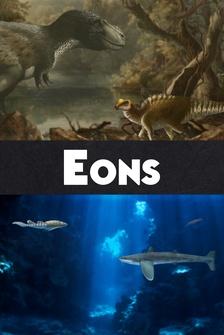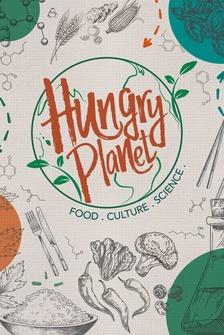[music] Broadcaster: Looks like today, we got to 101 degrees in the water on the north side of Key Largo.
You talking about straight ahead, right here, that little-- Yeah.
I think that is.
I think that's it, 'cause we're getting closer to it.
Water still, the sun is just radiating.
It's just absorbing all that heat.
Broadcaster 2: What we're worried about is the evisceration of what's left of the coral population.
Maiya May: All right.
I'm ready to jump in this water.
Whoo.
That's hot.
I'm Maiya May, and I'm fascinated by our dynamic planet, our weather, and our climate.
What began as a career in broadcast meteorology has become a mission to figure out where we are... Woman: Oh, my God!
and where we're going as we leave this long, stable climate period and enter the hockey stick era.
Man: This morning, scientists say the 101.1 degree temperature recorded at a buoy near Key Largo, Florida, this week may break a record for the highest observed sea surface temperature.
[music] This super-heated water moves out into the ocean, contributing to the heating of the Gulf Stream and the coral reefs.
Amy Clement: You know, if that happens in any one place, it's very easy to say, "Oh, that's an anomaly.
That just happened there."
But what's unique about this summer, in my experience, which is now 30 years I've been working on this, have not seen a particular summer that is this glaringly hot everywhere.
J. Marshall Shepherd: Warming in the ocean tends to find its way out through stronger hurricanes, changes in ocean patterns, coral bleaching, loss of sea ice in the Arctic region.
It's all connected.
For much of the last 10,000 years, our planet's climate has been remarkably stable in three important ways: temperature, atmospheric carbon dioxide, and sea level.
During this time, the human population went from 20 million people on Earth to 8 billion.
That stable climate period is what allowed the development of human civilization as we know it.
But that stability is gone, and the impacts aren't linear.
That's because of tipping points, and these are critical thresholds for our planet that, once crossed, can speed up and intensify the impacts of climate change, and they may not be reversible.
How well we understand these changes and how we choose to act will define our future for generations to come.
So join me in the field and in the lab to see what the brightest minds and the best science have to say about our changing weather and climate and how to prepare.
And I want to share why I'm more hopeful now than ever about confronting this global crisis, because exponential change, the kind that suddenly sneaks up on us, isn't always bad.
♪ So, Tim, you pioneered the study of climate tipping points almost 20 years ago.
So can you tell me what exactly is a tipping point?
Tim: So a tipping point is a threshold in the climate, which, if we cross it, we see major accelerating and potentially irreversible change.
It really looks like a different world if we cross these climate tipping points.
And the decisions we make in the next few years are gonna define our climate future.
We're talking about the major ice sheets on Antarctica and Greenland that together could give us 10 meters of sea level rise.
We're talking about major ocean currents that set the pattern of climate for all of us, and then the frozen permafrost of the High Arctic, which, as it thaws, it can release twice as much carbon as is currently in the atmosphere.
And then there's bits of the living biosphere, that Amazon rainforests and the coral reefs that half a billion people depend on for their livelihoods.
Maiya: Coral reefs are one of the most productive and biodiverse ecosystems on the planet.
Nearly 1/4 of all marine species rely on them, as well as hundreds of millions of people that count on them for food, income, and protection from extreme storms like hurricanes.
But an ocean that's too hot by even just a couple degrees could change everything.
So I went to Florida to find out how close we are to crossing this threshold during a record-breaking ocean heat wave.
I arrived while conservationists and scientists were carrying out the largest coral rescue attempt in history.
[music] Woman: All the teams in Florida kind of jumped into action to try to save as many corals as we can from the ocean.
We did that by actually removing individuals of all these different genotypes, every single genetic individual that we had, and bringing them here.
Maiya: It's a desperate attempt to save as much biodiversity as possible, allowing corals to wait out the heat wave in onshore nurseries.
Naturally growing coral can't be moved without damage, but young coral grown in labs and recently planted on ocean reefs can.
So dozens of scientists and researchers carefully removed the young corals as water temperatures reached deadly levels.
Each coral represents years of work towards creating a more resilient reef.
Liv Williamson: Most corals are animals, but in their tissues, they have this symbiotic algae.
They use energy from the sun to create foods through photosynthesis.
When the temperatures get too warm--let's say a little bit above 87, 88, into the 90s-- the algae actually stop being able to produce food for the corals, and instead they produce toxic chemicals.
Maiya: When this happens, the coral expel the colorful algae in an attempt to save themselves.
Liv: That's the process of bleaching.
Before this year, things were already pretty bleak, unfortunately.
It's estimated that about half of the world's corals had been lost already due to bleaching and other things.
Like many other climate impacts, damage from bleaching is binary.
Increasing heat has little impact until a threshold is crossed.
Then suddenly... [snaps fingers] the results are catastrophic.
If they remain bleached for too long, they starve and die.
It takes about eight weeks.
Coral bleaching itself is nothing new, but what is new is how often these bleaching events occur, making it difficult for coral to recover in between.
Too much bleaching too close together and we lose the living corals leading to the collapse of the reef structure where all of that biodiversity lives.
[music] So scientists developed ways to speed up recovery and to improve resilience, which I'm gonna see up close at Mote Marine Laboratory.
And this process may hold an important clue to whether or not a coral tipping point has been reached.
Jason.
Hi, Maiya.
How are you doing?
Very good.
Show me around.
Oh, come on in.
I'm so excited.
Man: This is staghorn coral.
Coral nurseries like this are places where we can radically increase the number of new coral colonies.
Maiya, voice-over: So we start with a piece of coral that we know is more resilient than average, because it has already survived a heat wave.
What we're gonna do is we're gonna take this coral here, and we're gonna fragment it into those micro-fragments, working with our bandsaw.
I don't know how accurate I'm gonna be.
I'm gonna try my best.
It'll be perfect.
[bandsaw whirring] Look at that.
Just a little dab.
Just a little.
Perfect.
We're ready to glue 'em, get 'em off to their new home in the land-based nurseries.
When we do our micro-fragmentation process, we're trying to achieve a dinner plate size for those corals 'cause that's about the rough size that the coral has to be to be sexually mature.
Maiya: Fragmenting the coral stimulates growth, shaving decades off the time it takes to reach maturity.
By propagating the most heat-tolerant coral, you speed up evolution and the reef can survive in warmer water.
But here's the tipping-point clue.
Most of these strategies that we've been developing have shown a lot of promise in trying to buy corals, you know, one to two degrees Celsius of heat tolerance.
What we're seeing this year is very surprising and scary because we're seeing a three-degree Celsius kind of temperature anomaly.
[music] Back in the 1960s and '70s and even into the '80s, there was roughly 30% to 60% of the reef surface was covered in living coral.
Today, before this thermal event, 2 to 5% of our reef is covered in living coral.
[music] Dead ahead.
That's the spot buoy, the big yellow one.
Maiya: I'm trying--is this-- Man: Right, yeah.
That's bleached coral right there.
Wow.
I didn't even-- I didn't even realize that's what that was.
That is crazy.
I wonder how warm this water is down here.
What I was looking at down here was bleached coral.
You can see it's completely white.
[music] Bleaching was everywhere, and this was the case for every reef that we went to.
Fish were still using the features, but if the reef-building coral have trouble recovering, the structure will eventually fall apart.
♪ Jason: On the bottom, it was fluctuating between 91 and 92 degrees Fahrenheit.
And then at the surface, there were definitely a couple of spots where we hit 93.
That is incredibly hot.
[chuckles] Coral after coral after coral that are bleached, I would estimate something much greater than 90% of the corals down there on this relatively high-coral cover site, were showing some signs of bleaching all the way through completely bleached.
And then a much lower proportion are obviously already dead.
So all of that bleaching is just over the last-- over the last couple of weeks.
Maiya: But there's still some hope for these corals.
If the temperatures drop back down quickly enough, they could survive.
So I'll come back to Florida later in the summer to see how they did.
It makes sense that sunny, tropical Florida is impacted by summer heat.
But what about one of the coldest cities in the U.S.?
We're headed to Fairbanks, Alaska, where much of the Arctic region is warming around four times faster than the global average, pushing another sensitive climate system towards a tipping point, permafrost.
[music] This frozen ground is estimated to contain more than 1,500 billion tons of carbon globally.
This is equivalent to twice the total amount of carbon that's currently in the Earth's atmosphere, including all the human-caused CO2 and methane emissions that have already warmed the planet near 1.5 degrees.
Global warming is gradually thawing this permafrost, releasing even more carbon into the atmosphere, leading to more warming and more thaw.
And I think you can see the problem here.
[music] Before the 2023 fire season, no one I talked to believed that a runaway feedback loop had been triggered here.
♪ But then 45 million acres burned in Canada, more than doubling the previous annual record.
Fires even burned into the Arctic circle, leaving vast areas of permafrost unprotected and uninsulated by vegetation, and more susceptible to the rising temperatures.
In the spring of 2024, over 100 so-called zombie fires reemerged after being buried under the snow and ice for the entire Arctic winter.
I couldn't help but wonder how this extreme fire behavior might impact the permafrost tipping point.
So to find out, we went to a study site where scientists can conveniently compare an unburned landscape with one that burned in 2019, side by side.
So here we are.
This is the boundary of the Hess Creek fire.
And what makes it unique is that it's happened over old carbon called Yedoma.
[music] Maiya: Yedoma is important because it's the most carbon-rich kind of permafrost.
It's made of underground ice wedges and organic matter that froze during the last ice age before it had time to decompose.
When Yedoma thaws, the organic matter begins to decompose, releasing the stored carbon into the atmosphere.
By measuring the carbon emissions from the soil here, scientists can understand the impact that fire has on the permafrost below.
This is gonna be our flux chamber for measuring... Chamber.
CO2 and methane.
Maiya: If we detect either of these gases in the burned area but not the unburned forest just across the highway, we'll know that the fire was responsible for initiating this permafrost thaw.
There can't be any openings, so... Nicholas, voice-over: When we first start measuring, we take a baseline of what's the general background CO2 in the atmosphere.
Maiya: By doing this, we're able to see whether the ground underneath us is absorbing or releasing CO2.
So what we can see is a net increase in CO2 emissions from this site.
Maiya: But just across the highway in the unburned forest, Nick's measurements reveal the opposite.
Here, trees and vegetation protect the permafrost below, keeping it frozen.
As it grows, the forest absorbs more carbon from the atmosphere than it releases, making it a carbon sink.
Nicholas: Underneath us is ancient, old ice age deposits.
And still today they're frozen.
And is that because of the trees and all the shrubs that we see around here?
Exactly.
But as soon as you strip back that ecosystem, you create disturbance, which creates a positive feedback, and that can lead to a tipping point.
But the key to understanding this tipping point lies in the Yedoma's deep ice wedges.
But this is kind of hard to understand from the surface because you can't see them.
So we're going underground.
So why do we need the flashlights?
Well, it's pretty spooky inside.
[music] All right.
Come on in.
Huh.
Ooh.
Yeah.
That's a smell.
Yes, it is.
I don't even know how to describe it.
Some people have said it's the smell of climate change.
You're seeing a bison, a mammoth, and a horse left over from the last ice age.
Wait.
can I touch it?
Yeah, go ahead.
So this right here, this is a woolly mammoth?
Nicholas: Yes, that's a woolly mammoth femur from the last ice age.
Maiya: Oh, my gosh.
Nicholas: But if you come over here, you can actually see that the plants are still green.
The plants never had a chance to decompose.
And so we can still see... Maiya: It's basically frozen in time.
That's right.
Wow.
And so the permafrost is essentially any ground or rock or soil or even plants and microbes that are frozen for two or more years.
But in this case, this particular spot, this material has been frozen for at least 15,000 years.
[music] At that time, the earth was warming as it emerged from the last ice age.
This thawed the very top layer of permafrost, turning it into soil where plants and even forests were able to grow.
These ecosystems then insulated the remaining Yedoma permafrost below, protecting it from further thaw.
But now things are changing.
Nicholas: So here you can actually see the ice wedge itself.
[music] And then look above you.
So the reason these ice wedges are so important is because, well, they're composed of water.
And when they're frozen, this keeps everything together.
But as they thaw, they can form wetlands such as thermokarst lakes, which actually convert this carbon into methane.
And methane is about 85 times more powerful as a greenhouse gas than CO2.
More on methane in a moment, but first, let's focus on the lakes creating it.
Water transfers heat very efficiently.
So once these ice wedges begin to melt, the thaw is almost contagious and spreads quickly, creating lots of smaller local tipping points.
So we're going to a different location near Fairbanks, where Nick believes an irreversible tipping point has already been crossed.
[music] Just a few decades ago, the Goldstream Valley was forested with few lakes.
But as the Yedoma thaws, the landscape is changing dramatically.
Nicholas: So a chunk of this is just falling into the lake, and these trees are falling in.
But you have to realize 50 years ago, this was all a permafrost plateau that's now transitioning into a lake.
And so what you'll find is a lot of methane-- extreme methane emissions here but none here.
And this lake is, we believe, the largest methane-emitting lake in the literature.
It's kind of wild to think that this was just frozen ground.
Now because of climate change, there's a whole lake here.
[music] And lakes like this are important for two big reasons.
One is that they convey heat to the surrounding permafrost, leading to the spread of further thaw and the creation of more lakes.
And two-when organic matter breaks down underwater, which is what happened here, it creates methane, and methane is a far more potent greenhouse gas.
When you strip back ecosystem-protected Yedoma, this exposes it to degradation and decomposition.
And it's like opening the freezer door, right?
What happens if you open the freezer door and you lose power to your food?
It goes bad.
It goes bad.
And why does it smell?
It's rotting.
It's decomposing.
It's decomposing.
Hmm.
Maiya: So does this mean we have triggered the permafrost tipping point, releasing all that arctic carbon into the atmosphere?
I asked Tim what he thought.
When we look down from space, we see that we're crossing quite a few permafrost tipping points locally, and they are visible as these craters or pock marks.
So the big concern is that we see those tipping points escalating and it becoming a much larger scale problem, an amplifier of climate change.
There are these extraordinary fires that we've seen in the last couple of years that are starting to hit and hurt the slow major carbon stores of the permafrost.
We've not seen the evidence for a global methane bomb that's amplifying warming, but we are seeing these localized tipping points, and we're starting to see them spread, which is a obvious sign for concern.
♪ Maiya: By the winter of 2023, water temperatures in Florida had dropped.
So we met up with Liv to get a sense of how much of the coral survived.
[music] Gas is on.
Awesome.
♪ Maiya: In the water, it was clear right away that the heat event was just too long and too intense for most of the reef to survive.
The bleached coral we saw earlier in the summer was no longer stark white.
It was brown, gray and dead.
♪ Well, that was even worse than I expected.
Not even one patch of light tissue on any of those corals.
[gentle waves breaking] Liv: Wow.
♪ These are corals that I've watched for years grow and reproduce and already be some of the last of their kind in this area.
And to watch them slowly die over the last few months, it's just been really heartbreaking.
It's real.
They're actually gone.
Maiya: And the same was true for almost all of the reefs in the Florida Keys.
Liv: I really fear that we may have reached, you know, something of a tipping point with these elkhorn and staghorn coral populations because they're just so depleted that, you know, there's just not that many of them left to work with.
[music] Maiya: As 2023 turned to 2024 and waters cooled in Florida and warmed in the Southern Hemisphere, authorities officially declared the fourth and most severe global bleaching event in recorded history.
In general, corals in the Indo-Pacific region have fared much better than those in the Caribbean because there are fewer human-caused stressors and higher biodiversity.
Still, 2024 was the fifth mass bleaching event on the Great Barrier Reef in just eight years.
And global sea surface temperatures in 2024 are breaking the shocking records of 2023.
The single most important factor in whether or not we reach a global tipping point for coral is the frequency of bleaching events.
So is it possible this threshold has already been crossed?
Tim: I think we tragically have crossed a tipping point for coral reefs.
We've seen the fourth great bleaching event for the reefs.
I thought it was gonna take us a decade to be sure that we'd passed a tipping point or not for the corals.
We're now having 12 months of 1.5 degrees centigrade of warming.
I think it's given us pretty clear evidence that big areas of coral reef are past their tipping point now.
Maiya: The coral and permafrost situations are scary, and there are only two of the five tipping points that are most likely to tip soon.
But Tim also said something that sums up how I'm starting to understand this moment of global change.
Tim: So whilst we're seeing this shocking news of the bad climate tipping points, we're also seeing the first compelling evidence for positive tipping points, and they're accelerating.
And we see that as exponential growth in the number of solar panels or wind turbines or electric vehicles that get rid of greenhouse gas emissions.
And it's like a kind of battle of the tipping points now.
You've got this escalating risk of the bad climate tipping points, but you also see the rise of the positive tipping points we need to stop or limit the risk from the bad tipping points.
Maiya: To prevent the earth from reaching irreversible tipping points, the science is very clear, we have to reach net zero by the middle of this century, and that's just a few decades away.
But what Tim says should also give us hope.
The truth is, we're adopting clean energy at an exponential rate.
And unless you're paying attention to every new advancement in real time, it's easy to miss the fact that now, for the first time in human history, we have a fighting chance at reaching net zero before it's too late.
Woman: Historical prediction of solar power have always underestimated the technology.
And by quite funny amounts, often projections about the next 10 years of solar uptake would usually be met within a single year.
When solar power is the cheapest form of electricity and it's been deployed, it's really difficult to make an economic case to start a new coal power plant.
The human species might not be great at a lot of things, like understanding exponential change, for one.
But I'd like to think that we're pretty good at innovating, which fuels my optimism about all this.
So in spite of seeing so many of the impacts of climate change firsthand, I'm feeling hopeful.
We're already feeling the impacts of our warming world, but there's a lot we can do to keep ourselves safe.
And that's exactly what we'll explore in our next episode.
It's a deep exploration of how we know when to adapt and when to leave.
♪ [rumbling] Maiya: Whoa!
♪ You can watch the rest of Weathered: Earth's Extremes on the PBS app.
All six episodes are available to stream now.
♪















